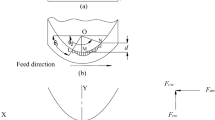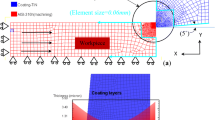Abstract
In the present paper an experimental study to investigate the turning of hardened AISI 6150 heat treatable steel using polycrystalline boron nitride (PCBN) tools is presented. Design and analysis of computer experiments (DACE) was used to generate a comprehensive empirical description of the process characteristics. More specific, the effects of the parameters cutting speed, feed and depth of cut on the objectives tool wear, tool life, tool life volume, surface finish and process forces were modeled. A total of 157 experiments was carried out with 15 different parameter-value sets to obtain the training data for modeling the progression of the objectives versus cutting path length and width of flank wear land. Pseudo-3D surface plots are generated to visualize the effects and interactions. Unexpected effects of depth of cut on tool life were found and the validity of conclusions about the effect of cutting speed on tool wear and tool life are discussed. Moreover, qualitative explanations for some of the observed effects are presented.












Similar content being viewed by others
References
Bhattacharya A, Das S, Majumder P, Batish A (2009) Estimating the effect of cutting parameters on surface finish and power consumption during high speed machining of aisi 1045 steel using taguchi design and anova. Prod Eng Res Dev 3:31–40
Biermann D, Weinert K, Wagner T (2008a) Model-based optimization revisited: towards real-world processes. In: Michalewicz Z, Reynolds RG (eds) 2008 IEEE congress on evolutionary computation (CEC 2008), Hong Kong, pp 3514–3521
Biermann D, Zabel A, Gruenert S, Sieben B, Wagner T (2008b) Machining of functional graded workpieces. In: Byrne G, O’Donnel G (eds) Proceedings of the 3rd CIRP international conference high performance cutting (HPC), Dublin, Ireland, pp 723–732
Caydas U, Hascalik A (2008) A study on surface roughness in abrasive waterjet machining process using artificial neural networks and regression analysis method. J Mater Process Technol 202:574–582
Chou YK, Evans CJ (1997) Tool wear mechanism in continuous cutting of hardened tool steels. Wear 212:59–65
Chou YK, Evans CJ (1999) Cubic boron nitride tool wear in interrupted hard cutting. Wear 225–299(Part 1):234–245
Choudhury I, El-Baradie M (1999) Machinability assessment of inconel 718 by factorial design of experiment coupled with response surface methodology. J Mater Process Technol 95(1–3):30–39
Costes J, Guillet Y, Poulachon G, Dessoly M (2007) Tool-life and wear mechanisms of cbn tools in machining of inconel 718. Int J Mach Tools Manuf 47:1081–1087
Davim JP, Gaitonde V, Karnik S (2008) Investigations into the effect of cutting conditions on surface roughness in turning of free machining steel by ann models. J Mater Process Technol 205:16–23
Denkena B, Boehnke D, Meyer R (2008) Reduction of wear induced surface zone effects during hard turning by means of new tool geometries. Prod Eng Res Dev 2:123–132
Diniz AE, de Oliveira AJ (2008) Hard turning of interrupted surface using cbn tools. J Mater Process Technol 195:275–281
Feng CX (2001) An experimental study of the impact of turning parameters on surface roughness. In: Proceedings of the 2001 industrial engineering research conference, vol 2036, pp 1–8
Hodgson T, Trendler P (1981) Turning hardened tool steels with cubic boron nitride inserts. CIRP Ann Manuf Technol 30(1):63–66
Huang Y, Liang SY (2005) Modeling of cutting forces under hard turning conditions considering tool wear effect. Trans Asme 1(27):262–270
Jones DR, Schonlau M, Welch WJ (1998) Efficient global optimization of expensive black-box functions. Glob Optim 13(4):455–492
Kishawy HA, Haglund A, Balazinski M (2006) Modelling of material side flow in hard turning. CIRP Ann Manuf Technol 55(1):85–88
Koehler JR, Owen AB (1996) Computer experiments. In: SG, RCR (eds) Handbook of statistics, vol 13. Elsevier Science B.V. Amsterdam
Koenig W, Wand T (1986) Hartdrehen von waelzlagerstahl mit pkb und schneidkeramik. Industrie-Diamanten-Rundschau 20:67–74
Koenig W, Komanduri R, Tönshoff H, Ackershott G (1984) Machining of hard materials. CIRP Ann Manuf Technol 33(2):417–427
Lin W, Lee B, Wu C (2001) Modeling the surface roughness and cutting force for turning. J Mater Process Technol 108(3):286–293
Liu K, Melkote S (2006) Effect of plastic side flow on surface roughness in micro-turning process. Int J Mach Tools Manuf 46:1778–1785
McKay MD, Beckman RJ, Conover WJ (2000) A comparison of three methods for selecting values of input variables in the analysis of output from a computer code. In: Technometrics 42, ISSN:0040-1706, pp 55–61
Molinari A, Nouari M (2002) Modeling of tool wear by diffusion in metal cutting. Wear 252:135–149
Muthukrishnan N, Davim JP (2009) Optimization of machining parameters of al/sic-mmc with anova and ann analysis. J Mater Process Technol 209:225–232
Nakai T, Nakatani S, Tomita K, Goto M (1991) Hard turning by pcbn. Conference Superabrasives ’91, SME-technical paper MR91-190, Chicago, Illinois, pp 1–15
Nakayama K, Arai M, Kanda T (1988) Machining characteristics of hard materials. CIRP Ann Manuf Technol 37(1):89–92
Nalbant M, Gokkaya H, Toktas I (2007) Comparison of regression and artificial neural network models for surface roughness prediction with the cutting parameters in cnc turning. Model Simul Eng 1:1–14
Narutaki N, Yamane Y (1979) Tool wear cutting temperature of cbn tools in machining of hardened steels. CIRP Ann Manuf Technol 28(1):23–28
Nowag L, Soelter J, Brinksmeier E (2007) Influence of turning parameters on distortion of bearing rings. Prod Eng Res Dev 1:135–139
Oezel T, Karpat Y (2005) Predictive modeling of surface roughness and tool wear in hard turning using regression and neural networks. Int J Mach Tools Manuf 45:467–479
Oezel T, Hsu TK, Zeren E (2005) Effects of cutting edge geometry, workpiece hardness, feed rate and cutting speed on surface roughness and forces in finish turning of hardened aisi h13 steel. International J Adv Manuf Technol 25:262–269
Park YW (2002) Tool material dependence of hard turning on the surface quality. Int J Korean Soc Precision Eng 3:76–82
Pavel R, Marinescu I, Deis M, Pillar J (2005) Effect of tool wear on surface finish for a case of continuous and interrupted hard turning. J Mater Process Technol 170:341–349
Penalva M, Arizmendi M, Diaz F, Fernandez J (2002) Effect of tool wear on roughness in hard turning. CIRP Ann Manuf Technol 51(1):57–60
Rahman M, Wong YS, Zareena AR (2003) Machinability of titanium alloys. Jpn Soc Mech Eng Int J 46(1):107–115
Ravindra H, Srinivasa Y, Krishnamurthy R (1993) Modelling of tool wear based on cutting forces in turning. Wear 169:25–32
Risbood K, Dixit U, Sahasrabudhe A (2003) Prediction of surface roughness and dimensional deviation by measuring cutting forces and vibrations in turning process. J Mater Process Technol 132(1–3):203–214
Sacks J, Welch WJ, Mitchell TJ, Wynn HP (1989) Design and analysis of computer experiments. Stat Sci 4:409–435
Santner TJ, Williams BJ, Notz WI (2003) Design and analysis of computer experiments. Springer Series in Statistics. Springer, New York
Soelter J, Brinksmeier E (2005) Parameter study of high speed turning of hardened steel. Prod Eng Res Dev 12(1):51–54
Stovicek D (1992) Hard-part turning. eliminates grinding, improves quality. Tool Prod Mag Metalworking Manuf 57:25–26
Suresh P, Rao PV, Deshmukh S (2002) A genetic algoritmic approach for optimization of surface roughness prediction model. Int J Mach Tools Manuf 42:675–680
Tamizharasan T, Selvaraj T, Noorul Haq A, (2006) Analysis of tool wear and surface finish in hard turning. Int J Adv Manuf Technol 28:671–679
Tosun N, Oezler L (2002) A study of tool life in hot machining using artificial neural networks and regression analysis method. J Mater Process Technol 124:99–104
Wagner T, Paßmann D, Weinert K, Biermann D, Bledzki A (2008) Efficient modeling and optimization of the property gradation of self-reinoforced polypropylene sheets within a thermo-mechanical compaction process. In: Proceedings of the 6th CIRP international conference on intelligent computation in manufacturing engineering, pp 447–452
Wang X, Feng C (2002) Development of empirical models for surface roughness prediction in finish turning. Int J Adv Manuf Technol 20(5):348–356
Warnecke G, Bach P (1988) Mechanical and material influences on machined surface in precision turning of steel with ceramics. In: Transactions of the North American research conference, vol 16, pp 209–216
Acknowledgments
This paper is based on investigations of the collaborative research center SFB/TR TRR 30, which is kindly supported by the DFG.
Author information
Authors and Affiliations
Corresponding author
Rights and permissions
About this article
Cite this article
Sieben, B., Wagner, T. & Biermann, D. Empirical modeling of hard turning of AISI 6150 steel using design and analysis of computer experiments. Prod. Eng. Res. Devel. 4, 115–125 (2010). https://doi.org/10.1007/s11740-010-0208-7
Received:
Accepted:
Published:
Issue Date:
DOI: https://doi.org/10.1007/s11740-010-0208-7




